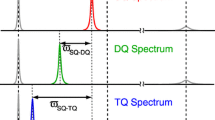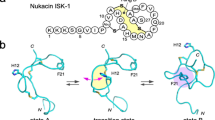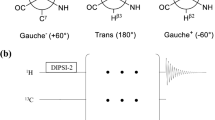Summary
The dynamic behaviour of the guanidino group of arginine has been investigated quantitatively with the intention of providing a set of basis values for the interpretation of data acquired for arginine residues in proteins. At room temperature, a single broad resonance line is observed for the four η-NH2 protons. Upon cooling the sample (≈10°C at 500 MHz), two η-NH2 proton resonances are resolved which were shown by HMQC spectroscopy to be the result of slowed rotation about the Nε−Cζ partial double bond. The flip rate (kNC) about the Nε−Cζ bond was measured as a function of temperature using line-shape analysis of both 1H and 15N NMR spectra; at 25°C, kNC is between 900 and 1000 s-1. The exchange broadening, due to Nε−Cζ bond flips, typically results in weak or missing signals for the η-NH2 protons of arginine residues in HMQC or INEPT experiments recorded at room temperature, unless the motion is restricted in some way. In a related series of experiments, the pH dependence of the hydrogen exchange rates of the ε-NH and η-NH2 protons of arginine was measured using saturation transfer 1H NMR spectroscopy and compared with the equivalent NH2 protons of the guanidinium ion. As expected, OH ion catalysis dominates over most of the pH range and proceeds at a rate close to the diffusion limit for both types of proton (kOH=2×109−1×1010 M-1s-1, depending on conditions). At low pH values, however, catalysis by H3O+ becomes important and leads to characteristic rate minima in the exchange versus pH profiles. Acid catalysis is significantly more effective for the η-NH2 protons than for the ε-NH proton; at low ionic strength (50 mM KCl) the rate minima occurred at pH 3.6 and 2.3, respectively. Under these conditions, acid-catalysed rate constants (kH) of 706 M-1s-1 (η-NH2) and 3 M-1s-1 (ε-NH) were obtained at 25°C. At high ionic strength (1 M KCl) the rate of OH- ion catalysis is decreased slightly, whereas the H3O+-catalysed rate is unchanged. The kOH value of the free guanidinium ion is identical to that of the η-NH2 protons but acid catalysis occurs less easily, leading to a rate minimum at pH 3.3.
Similar content being viewed by others
Abbreviations
- HMQC:
-
heteronuclear multiple-quantum coherence
- DEPT:
-
distortionless enhancement by polarisation transfer
- HSQC:
-
heteronuclear single-quantum coherence
- INEPT:
-
insensitive nucleus enhancement by polarisation transfer; ppm, parts per million
- T1 :
-
spin-lattice relaxation time
- T2 :
-
spin-spin relaxation time
References
BalashovS.P., GovindjeeR., KonoM., ImashevaM., LukashevE., EbreyT.G., CrouchR.J., MenickD.R. and FengY. (1993) Biochemistry, 32, 10331–10343.
BaxA., GriffeyR.H. and HawkinsB.L. (1983) J. Magn. Reson., 55, 301–315.
BlombergF., MaurerW. and RüterjansH. (1978) Proc. Natl. Acad. Sci. USA, 73, 1409–1413.
BodenhausenG. and RubenD.J. (1980) Chem. Phys. Lett., 69, 185–189.
CottonA., LaCoeurT., HazenE.E. and LeggM.J. (1977) Biochim. Biophys. Acta, 481, 1–5.
EigenM. and HammesG.G. (1963) Adv. Enzymol., 25, 1–38.
EnglanderS.W. and KallenbachN.R. (1984) Q. Rev. Biochem., 16, 521–655.
HoreP.J. (1983) J. Magn. Reson., 55, 283–300.
JardetzkyO. and RobertsG.C.K. (1981) NMR in Molecular Biology, Academic Press, New York, NY, p. 120.
KanamoriK., CainA.H. and RobertsJ.D. (1978) J. Am. Chem. Soc., 100, 4979–4981.
KarleI.L. and KarleJ. (1964) Acta Crystallogr., 17, 835–841.
KnowlesJ.R. (1980) Annu. Rev. Biochem., 49, 877–919.
LehmannM.S., VerbistJ.J., HamiltonW.C. and KoetzleT.F. (1973) J. Chem. Soc., Perkin Trans. II, 133–137.
McConnellH.M. (1958) J. Chem. Phys., 28, 430–431.
MenickD.R., CarrascoN., AntesL., PatelL. and KabackH.R. (1987) Biochemistry, 26, 6638–6644.
MuchmoreD.C., McIntoshL.P., RussellC.B., AndersonD.B. and DahlquistF.W. (1989) Methods Enzymol., 177, 44–73.
PavletichN.P. and PaboC.O. (1991) Science, 252, 807–817.
RiordanJ.F., McElvaneyK.D. and BordersC.L. (1977) Science, 195, 884–886.
SchmidtC.L.A., KirkP.L. and ApplemanW.K. (1930) J. Biol. Chem., 88, 285–293.
SeniorA.E. (1990) Annu. Rev. Biophys. Biophys. Chem., 19, 7–41.
SrinivasanP.R. and LichterR.L. (1977) J. Magn. Reson., 28, 227–234.
WüthrichK. and WagnerG. (1979) J. Mol. Biol., 130, 1–18.
YavariI. and RobertsJ.D. (1978) Biochem. Biophys. Res. Commun., 83, 635–640.
Author information
Authors and Affiliations
Rights and permissions
About this article
Cite this article
Henry, G.D., Sykes, B.D. Determination of the rotational dynamics and pH dependence of the hydrogen exchange rates of the arginine guanidino group using NMR spectroscopy. J Biomol NMR 6, 59–66 (1995). https://doi.org/10.1007/BF00417492
Received:
Accepted:
Issue Date:
DOI: https://doi.org/10.1007/BF00417492




